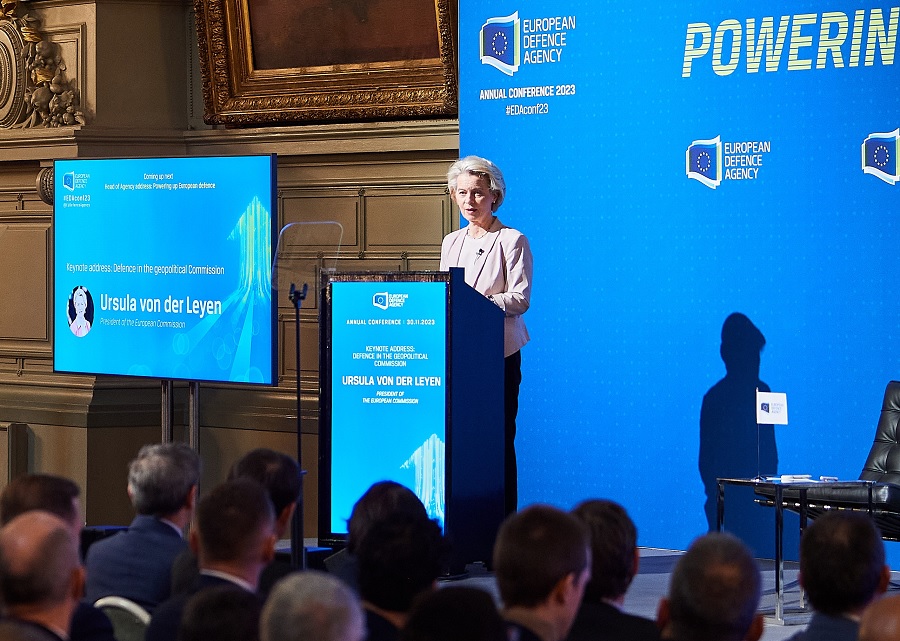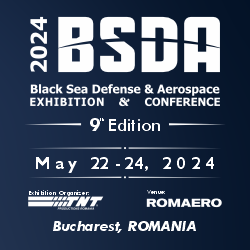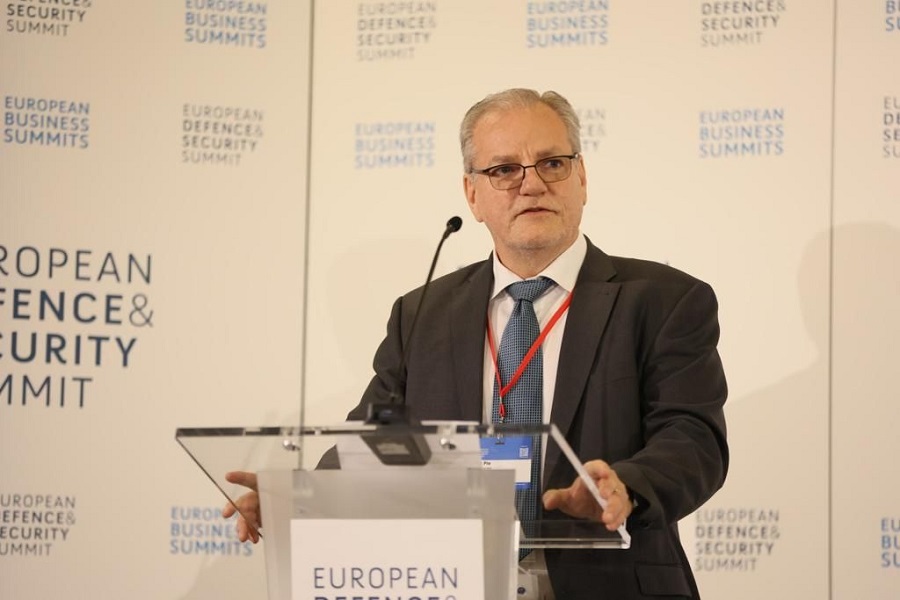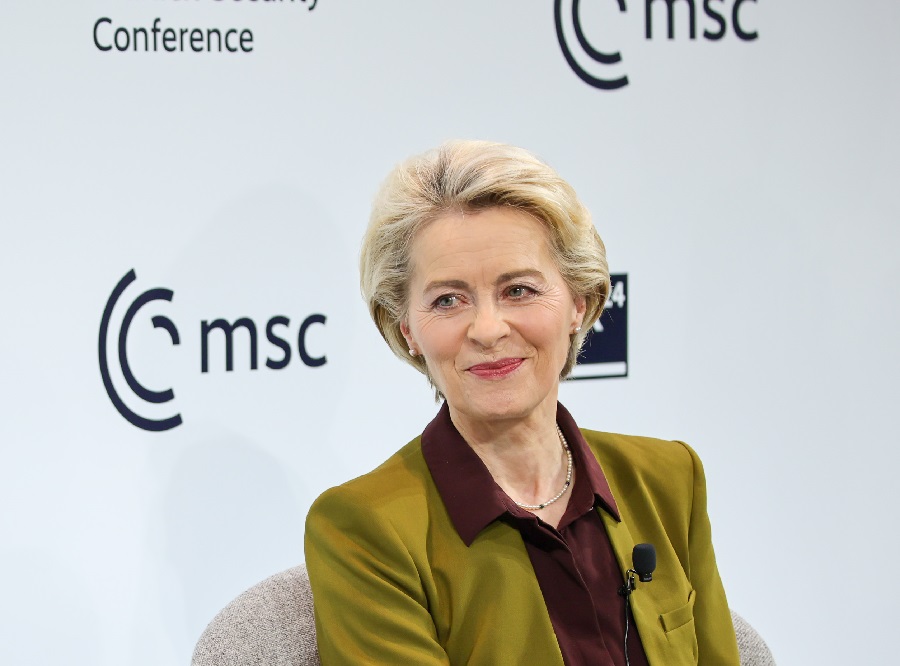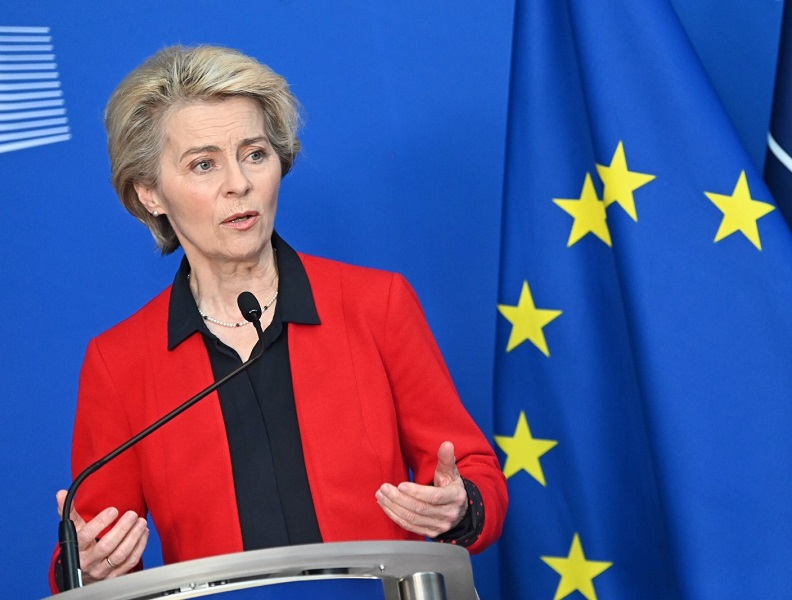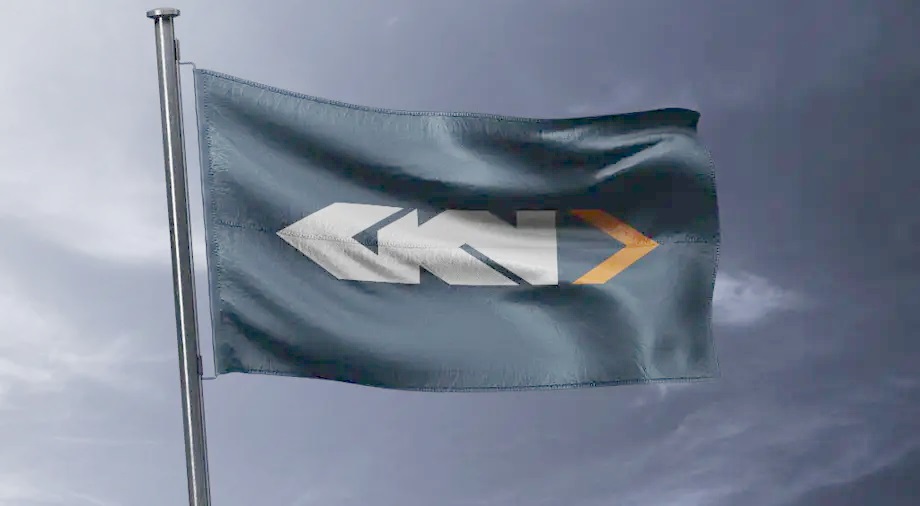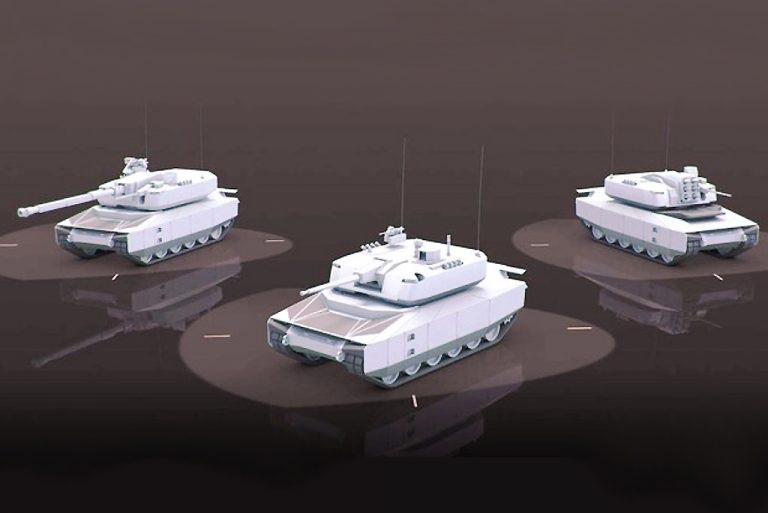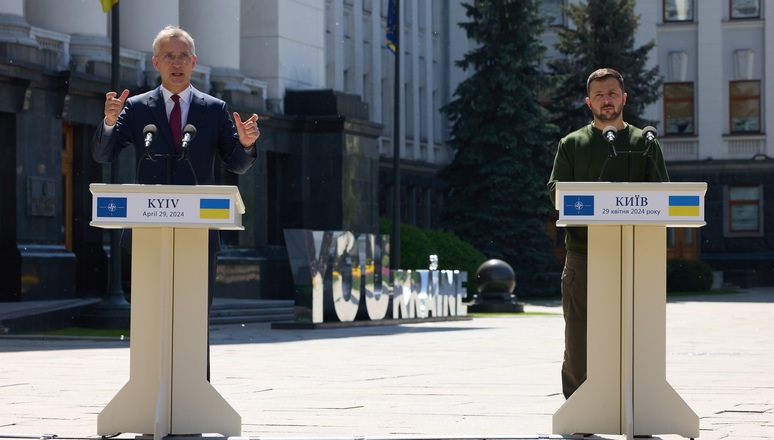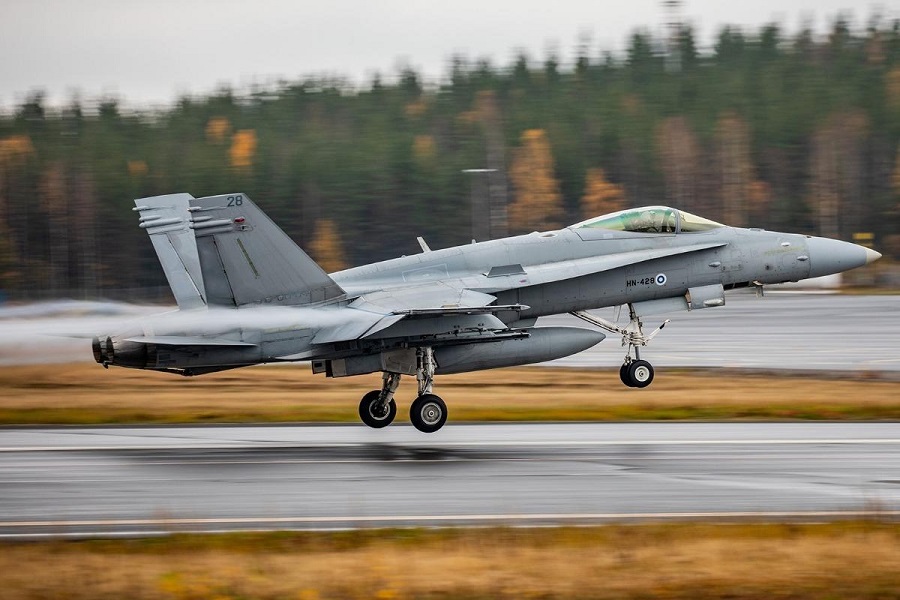Chief Executive, dear Jiří,
Ministers,
Ladies and Gentlemen,
Thank you very much for the invitation. It is a big pleasure for me to be back to the European Defence Agency. You might not all know that, for five years, I had the honour to sit on its board. So I could witness, firsthand, the role of the EDA as the pivot of European defence cooperation. But I must also say that in the last four years, I learnt something more about the EDA. And that is how you work not only with national Defence Ministries but with all European institutions. We have seen it since Russian tanks rolled into Ukraine. All of Europe has sustained Ukraine’s war effort. And of course, this has required a great deal of collaboration between different institutions, including the Agency and the Commission.
Our Defence Joint Procurement Task Force, for example, is helping us to match the demand from our Member States with the production capacities of our industry. Together, we have powered up Ukraine’s resistance. We have demonstrated what we can achieve as a Union when we join forces across borders and institutions, and together with partners at NATO. And this closer defence cooperation will be more and more necessary.
We all you know that the strategic environment around us has fundamentally changed. This creates a new kind of responsibility for Europe. I call it strategic responsibility. It is a responsibility, first of all, to support Ukraine in this war, for as long as it takes. This will not be easy – but this is exactly when our commitment needs to be rock-solid. Russia is now reinforcing its positions. Trying to re-take the initiative. And this means that the situation on the battlefield remains very challenging. But this is not an argument against support. On the contrary, it is an argument for more support. Because, let us not forget: When Putin invaded Ukraine, many of us thought that it would only take days to take Kyiv. This has not happened. Currently, Putin does not even control all the territories he has already annexed. Ukraine has driven Russia out of half the territories captured after February 2022. Ukraine has even pushed the Russian fleet in the Black Sea back and is able to deliver grain again through this maritime corridor. Finland has become a NATO member, with a long border with Russia. Sweden soon will be. Ukraine is on its way to EU membership. The Kremlin has deprived itself of access to Western economies and innovation systems and made itself dependent on China. We have achieved a lot together. And all these are good arguments for sustained support to Ukraine. At the same time, we must also look at Ukraine’s security in the medium and long term. Ukraine must have the capabilities to deter future attacks by Russia. This is why the EU’s future security commitments to Ukraine are so vital.
But strategic responsibility is not only about Ukraine. It is also about the other future members of our Union, like the Western Balkans, where long-standing local grievances are now being manipulated by external action. And if we look only a bit further, conflicts have multiplied all around our borders. I think of course of the Middle East but also of the Sahel and the Caucasus.
Globally, strategic competition is intensifying. Our partners are asking for greater European engagement in other parts of the world, such as the Indo-Pacific. And we must recognise that our security is more closely interlinked than ever before. We have learnt that when a big country threatens a small neighbour, the whole rules-based global order is at stake. And of course, our trade routes and supply chains are also exposed. Europe might be called to play a role in any of these theatres – near or far. So we need Member States’ armed forces that are prepared for all sorts of scenarios – from traditional to hybrid. On land, at sea, in the air, in outer space or cyberspace.
We always say that our Union was born as a peace project. And yes, this is right. But peace requires security. And that is why our Union was also born as a security project. Its industrial genesis, with coal and steel, had a central security dimension. In those sectors, the common industrial policy was basically security policy. And then, through the decades, this security dimension has grown. I am not only referring to the birth of this Agency, or to our missions and operations. Most of our Union’s policies have direct security implications. Our transport policy, for military mobility. Our agricultural policy, for food security. From trade to research, from energy to communications. At times of unprecedented threats, we must refocus our attention on the security dimension of all our policies. We must once again think about our Union as, intrinsically, a security project.
Of course, and this is very important, collective defence remains primarily the responsibility of Member States and of NATO. And we fully respect this specific point. Our cooperation with NATO remains central – it is excellent and it is stronger than ever. But strategic responsibility also calls for a stronger European contribution within NATO and to NATO. And since the beginning of Russia’s full-scale war of aggression, the idea of strategic responsibility has driven our work on defence. So today, I want to focus on how the work we have done so far can shape our future progress on European defence.
Ladies and Gentlemen,
The European Defence Agency is about to turn 20. We have built our defence cooperation step by step, brick by brick. And when Russia invaded Ukraine in 2022, decades of patient excellent work allowed us to react quickly and decisively. We have resorted to every tool in our hands, in unprecedented ways. Let me just explain a few of those. We had created the European Peace Facility to strengthen our role as security provider on other continents. Now, for the first time ever, we are giving military aid to a country at war, right here in Europe. EUR 5.6 billion, coordinated at EU level, to deliver tanks, helicopters, air defence systems, missiles and ammunition to Ukraine.
We had organised training missions before. Now, for the first time ever, we are training troops involved in an interstate European war, with a mission commanded by the new Brussels headquarters. We had created the European Defence Fund and PESCO – I remember that very well from my time as Defence Minister – to promote cooperative defence spending. Now, for the first time ever, we are mobilising Europe’s defence industry to sustain a war effort. The European Defence Fund has been complemented by EDIRPA. And it has led to ASAP, the Act in Support of Ammunition Production. 480,000 rounds of artillery shells have been either delivered or are in the pipeline. And already next year, we will be able to produce one million rounds per year. This would have been unimaginable just two years ago. And it already marks a massive step forward for our defence cooperation.
What we have done would be extraordinary in normal times. But in these extraordinary times, it is not enough. The war in Ukraine demonstrates that we need to produce more. Both to meet Ukraine’s needs, and to ensure our own deterrence and defence. The war in Ukraine is consuming more hardware than any other war in recent history. Russia has fired 10 million shells in a year. Ukraine consumes 10,000 drones per month. This means that Europe’s defence industry must mobilise, too. The reality is that we did not have sufficient weapons and ammunition available. No large stocks. And a lack of spare capacity. Because in peacetime, we thought we did not need them. This needed to change. In July, NATO leaders endorsed a new NATO Defence Production Action Plan. And here in the European Union, we need to be laser-focused on our own production capabilities. No industrial bottleneck should prevent us from securing Europe.
There is no lack of European instruments at our disposal. There are projects of great interest: from long-range drones to a system to detect and neutralise sea mines that could prove vital, for instance, in the Black Sea. But overall, our instruments for cooperation are still punching below their weight.
The good news is that there is much greater scope for the necessary investments, after the recent surge in many national defence budgets. The 2% NATO goal is within reach for more and more Member States. And this is good because strategic responsibility requires adequate defence spending. But how is the money spent? Collaborative spending by Member States has only slightly improved. It is still below 20%, very far from our goal of 35%. And on top of this, the latest figures show that additional funds are in large majority spent outside the European Union. We are predominantly buying alone and buying abroad.
Of course, this is happening because of the urgency to get weapons to Ukraine and restock national inventories. But this wave of short-term acquisitions will have a long-term impact: First of all, it has an economic cost. When Member States buy in an uncoordinated way, this may drive prices up. Secondly, it has a competitiveness cost for our industry. These investments could foster innovation and economies of scale in Europe, instead of buying off-the-shelf products elsewhere. Thirdly, it has a military cost. There are way too many different weapon systems in Europe. And this leads to a lack of interoperability.
There are many examples. But let me give you one. The Dutch-German brigade uses the same type of howitzer. But the Dutch have a certain type of ammunition for their howitzer; the Germans have a certain type of ammunition for their howitzer; and they are not interoperable. They cannot use each other’s ammunition. This is just one example. But you all know here in the room many other examples. And we could give you many other more. This cannot continue. Finally, buying alone and buying abroad may also have a security cost. We should not assume that we will always be able to rely on the international market for our defence procurement. We must look into our strategic dependencies to avoid operational consequences on the battlefield. Just like we need military readiness in a fast-changing security environment, we also need industrial readiness. This is an essential component of strategic responsibility. We must move from a logic of emergency response to one of long-term security. We need to make up for decades of under-investment and fragmentation. And to overcome this, we need to spend more, spend better and spend together.
Ladies and Gentlemen,
Transatlantic cooperation will remain essential, including from an industrial point of view. But we also need a stronger European reflex. We must think European, from planning to procurement. There are lessons here that we can learn from our recent history, beyond the defence and security field. In the four years of this mandate, Europe’s way of doing industrial policy has been transformed. For instance, on hydrogen, on semiconductors – chips –, or on critical raw materials. There was, first, a political decision taken at European level. Our Union agreed to focus on certain critical industries that are central for our economy of tomorrow. Then, we improved our rules to facilitate investment and innovation. For instance, with faster permitting and emergency frameworks. And finally, we backed our new industrial priorities with European and national funds to address market failures. This is the approach that we would also like to replicate with a new European Defence Industrial Strategy. This European Defence Industrial Strategy will focus on four strands of work. Let me display them.
First, strategic planning. Of course, we can build on the Strategic Compass and on the work the EDA is doing with Member States to coordinate national defence planning. But to deliver on our strategic priorities, we need even more joint programming. We should identify flagship capabilities at European level, projects of common interest on which we must focus our efforts and resources. For instance, capabilities that are European by nature: strategic enablers, like cyber capabilities, satellites, or strategic transportation. But I also think of complex platforms that are beyond the capacity of individual Member States, like air defence, and that can benefit from European scale. So we need a strategic planning function that ties together national and EU-level planning. This will give predictability to the industry and reduce fragmentation on the demand and supply sides.
Second, we need simpler and more efficient rules. Just like we did in other fields, we can use our regulatory framework to foster and simplify cooperation. This is even more necessary in a heavily regulated sector like defence. So, in the consultation phase of our strategy, we will ask our industry how we can best support it. We need an updated regulatory framework to give the industry and Member States predictability and coherence on a continental scale.
My third point is maximise our dual-use potential. While we strengthen our defence-specific research and development, we should also better integrate civilian technologies in our defence industrial base. We have already done this, for instance on military mobility. Dual-use transport infrastructure – you are well familiar with that, like roads and bridges that are used by military convoys –, is essential for our security and deterrence. So, we have worked with the transport community, and accelerated the use of our funds and policies in that field. It is still work in progress, but it is already one of the success stories of European defence. And this dual-use model is also applied in other sectors. For instance, on satellites for global positioning and secure connectivity. We already have Galileo, and we will soon have IRIS², which are EU assets and serve a military function. And we are laying the ground for a European cyber shield. So the European Union could have a direct role in creating new dual-use infrastructure. There is so much vital innovation with defence applications that emerges from civilian activities. It is now important that we connect the dots. And for this, the Commission will set out options in a White Paper on dual-use research.
My fourth point is about mobilising public and private funding. A suite of funding instruments is already available. But we must explore all possible ways to reward, incentivise, and compensate costs of cooperation and industrial competitiveness. The Strategy will do so, including by suggesting new funding possibilities. We will propose a European Defence Industry Programme early next year. This will integrate the experience of ASAP and EDIRPA. And of course, without prejudging the negotiations on the future EU budget, it needs to be adequately funded. We are also looking at how to incentivise the transition from cooperative research under the EDF to the development and full-scale industrial production of defence systems. ASAP was a good first step, but of course it was limited to an already mature product: this is ammunition. So we should look at the whole cycle of capability development – including the stage of industrial implementation and industrial production. All with a view to guide and support our defence technological and industrial base, in light of our strategic priorities. This would allow for greater coherence and coordination.
But there are other options too. We are already working on a VAT exemption to support the joint procurement and joint ownership of defence capabilities. We have already called on the European Investment Bank to enhance its support to the European defence industry. This call was recently echoed by the Member States in the EDA Steering Board – many thanks for that. So, I believe it is time to finally move ahead. We are looking at how the defence industry’s contribution to the security of the Union can be better recognised by sustainable financial investors and at how SMEs and start-ups in the defence sector can get access to growth finance. We should finally also be open to lessons from our partners. Let me give you an example: the lesson how the United States create stable demand for industry, lower costs and facilitate export transactions through their Foreign Military Sales programme.
We should also explore synergies with other industrial policies. For example, our Critical Raw Materials Act that has identified some minerals that are needed for our defence and space industries. If we are to take strategic responsibility, we need these vital value chains. And this work can only be done on a continental scale.
And finally, my fifth point, we must close the discussions on how defence investments can be taken into account under our fiscal governance rules. As a matter of transparency, spending on defence must be counted in public debt and deficits, like any other category. It can and should meet two compatible objectives: ensure sustainable public finances, and support Member States’ investment efforts in strategic public goods.
And this applies also to defence capabilities, in response to the more threatening geopolitical context. Especially because Member States have very different starting points in this area. So already in the Commission’s proposal last April, we identified defence among the EU priorities for investment and reforms. This could underpin the extension of a Member State’s fiscal adjustment period. In the Council, there is now broad support to consider increases in defence spending as a relevant factor when we assess whether a Member State has an excessive deficit or not. And there is room for further targeted and time-limited adaptations – to reduce the near-term fiscal efforts for Member States that are simultaneously increasing their defence spending. This could be particularly relevant for investments in the identified critical capability gaps. In addition, these investments would have to be European collaborative projects. This would generate a specific incentive for cross-border projects in Europe that are so much needed. If acceptable, co-legislators could consider these suggestions while finalising the current proposals. This could be a game changer for the Union’s defence and its defence industrial policies in these exceptional times.
So: Strategic focus. Better rules. Dual use. And funding. These are the four main pillars of our upcoming strategy. But at the end, there are some more topics that I want to raise about the geographic scope of our work. A strategic approach to our defence industry must also look into the question of Ukraine’s defence capabilities on top of our own needs. Our Strategy can only be complete if it also takes into account Ukraine’s needs and Ukraine’s industrial capacity. The first step to achieve this is to involve Ukraine in the consultation process of the Industrial Strategy. This should lead to integrating Ukraine in some of our defence programmes, with the agreement of the European Parliament and Council, where necessary. This would not only help us cater for Ukraine’s defence needs. It would of course also encourage convergence and joint planning, between our militaries and defence industries. Ukraine is a future member of our European Union. So it must get much closer to us and much faster. And we should use all our tools to make this happen.
Ladies and Gentlemen,
These last years have shown that when there is a political will, there is a way. When we come together, things that were stuck for years can start moving again. In these eventful times, we must be driven by a strong sense of urgency. And we must expand our cooperation as much as possible, in the current institutional boundaries. But we should not shy away from asking bold questions about the future of European defence. We will not be able to answer all these questions in the short term, in the few months ahead of the European elections. But we should still strive to set out a vision for the next steps. And imagine how the industrial and security policy tools that support our strategic responsibility can help to complete our European Defence Union. To me, the most urgent would be to look into new possibilities for our defence cooperation under the current Treaties. There are strong arguments to align the procurement conditions of the EPF and EDIRPA. Both can serve the immediate procurement needs of Member States and of Ukraine, as well as reinforcing the European and Ukrainian defence industrial bases. Both functions are vital to the long-term security of the Member States and of Ukraine. And while respecting the constraints of the Treaties, I see scope to discuss whether at least that function of the EPF could be supported by the Union budget, in a future Multiannual Financial Framework.
These are questions that we should ask already today. And this is why we will already make proposals in our contribution to the Leaders’ discussions on the future of Europe, that will be held under the Belgian Presidency in the first half of 2024.
Ladies and Gentlemen,
Our Union’s founders believed that defence and security had to be central in the European project. Today, this is more true than ever before. We have made tangible progress towards a European Defence Union. But the strategic challenges we face have grown even faster. Now, look at how much our Union has changed in recent years. When the pandemic hit, we all realised that we needed more integration to address health emergencies. And since then, we have laid the foundations of a European Health Union. When Russia tried to blackmail us with gas, we all realised that we needed common investment, common action and even a common aggregate purchase of gas. And since then, the European Energy Union has advanced more than ever before. The next chapter is a fully fledged European Defence Union. So that Europe can finally take strategic responsibility for its own future. It is one of the big tasks that our Union faces for the years ahead. And I am confident that Europe will once again answer to the call of history.
Thank you very much, and long live Europe.



